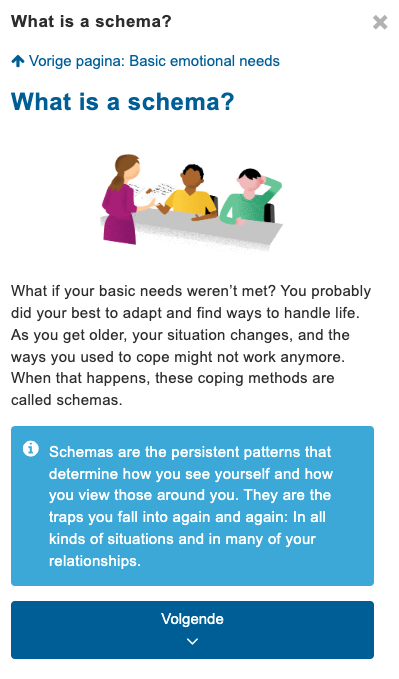Schema Therapy
Recognizing and Breaking Patterns with Schema Therapy
Schema therapy can help break persistent patterns: people learn to recognise patterns and discover where they come from. In schema therapy, those persistent patterns are called schemas and modes.
Contact MinddistrictWho is ‘Schema therapy’ for?
Professionals can use the module with clients who have persistent patterns: personality problems or personality disorders. If there are comorbid issues such as mood disorders, anxiety disorders, eating disorders, substance abuse, or relationship problems, these Axis I problems must be addressed before starting the module.
The development group recommends that the module be used by therapists who are qualified and recognised schema therapists or are under the supervision of a recognised schema therapist. The module is structured as a blended treatment, combining online sessions with individual schema therapy sessions and/or group therapy.
The suggested order of sessions is the most common, but therapists can choose to skip sessions. Before or during the module, the client must complete two questionnaires: the YSQ and the SMI.
What is the content of the ‘Schema therapy ‘module?
The module consists of 10 sessions, 4 of which are optional. It also includes 2 diaries and 1 schema, the case conceptualisation. The sessions contain psycho-education and exercises that clients can practice with.
In the 'Schema therapy' module, the following goals are most important for the client: • Becoming aware of and recognising schemas/modes that are problematic. • Gaining initial insight into the development of these schemas/modes and the deficiencies in emotional needs. • Mapping out one’s own situation, complaints, strengths, and coping styles. • Beginning to draw connections between causal factors (such as temperament, upbringing, traumatic experiences, life rules) and the schemas/modes and resulting issues. • Becoming aware of and recognising triggers that activate schemas/modes. • Gaining knowledge about experiential, cognitive, and behavioural techniques and developing an open attitude towards treatment.
Which diaries are part of the module?
Two diaries are included in the module:
- Schema therapy
- Schematherapy – in depth
The Schema therapy diary is automatically activated for the client after the session on triggers. In this diary, the client can keep track of the situations in which schemas and modes become active. The client answers a number of questions similar to the thought scheme and reflects on whether their feelings remind them of a past event. The client notes which schemas and modes were active at that moment. The client also reflects on what they actually needed in the situation (basic emotional needs).
The diary Schema therapy - in depth dives deeper into the ‘Schema therapy’ diary. It contains the same inventory questions, but additionally deals with challenging the active schema or mode. The client evaluates what part they and the other person played in the situation. The client also reflects on what they could have done differently to meet their needs. This diary is automatically activated after the session about ‘exercises focused on thoughts.
How do you use the ‘Schema therapy’ module?
The module is set up as blended treatment: the online sessions are alternated with face-to-face sessions or video calls. The therapist can tailor the treatment to the client by repeating or deleting sessions. The order of sessions can also be changed. The established order is the most common, but the therapist can choose to move sessions forward or towards the end of the (online) treatment. Sessions can be used independently of each other.
What is the module based on?
The module is based on Dr. Jeffrey Young’s "Schema Theory" and the Schema Therapy Institute. It was developed by Helga Pruiksma (KP psychologist/psychotherapist, schema therapy supervisor, and behavioural therapy supervisor VGCT) and Hanneke Huizing (advanced nurse and sociotherapist) from Lentis Groningen, Margreet de Peinder (GZ psychologist, junior schema therapist, and cognitive behavioural therapist VGCT in training) and Marieke van den Broek (GZ psychologist and cognitive behavioural therapist VGCT in training) from GGZ Delfland, Simone Walhout (psychotherapist, GZ psychologist, schema therapy supervisor, and cognitive behavioural therapist VGCT) and Sandra Verheijden (GZ psychologist and junior schema therapist) from GGZ Oost Brabant, Marion Kwakman (GZ psychologist, psychotherapist, and senior schema therapist) from GGZ Noord Holland Noord, and intervention developers Sarafina Suransky and Emma Ruigt from Minddistrict.
Experience experts were involved at every stage of the development process. The development process is based on the intervention mapping method. The content of the module comes from relevant literature as well as therapists‘ and clients’ knowledge and experience of schema therapy.
Would you like to know more about the development process of this module? Please contact the person responsible for ehealth in your organisation.
In short
- The module can be followed in the mobile app.
- Contains 2 diaries.
- The case conceptualisation on the home page automatically fills in answers from the module.
- Sessions that are not applicable can be skipped.
- Additional modules ‘Schematherapy: case conceptualisation’ and ‘Schematherapy: more about exercises’ can be used separately.
Get in touch with us!
Are you interested in using this intervention in your work as a care provider? Or do you want more information? Please get in touch with your account manager or contact us.


